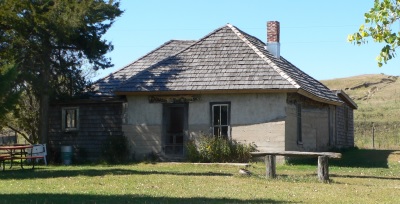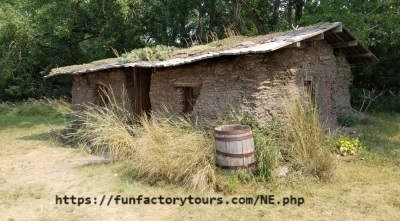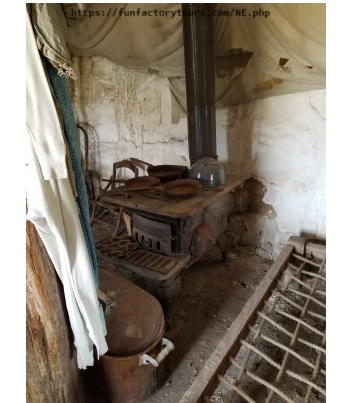Nebraska factories to visit and tour
Nebraska has factories to visit and tour. Below, first are the active, working factories. The next section has historical operations which often have demonstrations or renactments. These incluse both large and small operations, from several person chocolate factories and cheesemakers to large manufacturers making paper towels, wood products, beverage cans and bottles, are open to the public with real tours, exhibitions and fun education.
In some cases, such as a manufacturing process that is no longer in use, the only way to see it and learn about it is a museum or living history center. So, we also provide information about engineering facilities and museums, dinosaur digs, even government facilities, like NASA, astronomy oberservatories and more that are open to the public on certain days and times. And if there is some place that is just plain fun to visit, we add that, too!
These are perfect for homeschooling, for STEM and for fun! Kids love visiting these places! They're learning and getting an education without even realizing it. And most of these are either free or under $10! What's better then fun, entertaining, good for children and families, educational and free?
Here are some of the top factory tours in Nebraska and contact information and tips about visiting them.
Factories, Engineering, Museums and other fun demonstrations and exhibits to visit in Nebraska
- Hornady Bullet Factory - ammunition manufacturer
3625 W Old Potash Hwy, Grand Island, NE 68803. Phone: 800-338-3220. Phone: 308-382-1390. Call to see if they are still offering a tour, there's nothing on their website as of 10/2023, but there had been in the past. Hornady makes bullets, and each step of the bullet-making process is shown. For age 13 and up.
- Douse Sod House - a sod house in Custer County in the central Nebraska,
80560 Oak Grove Rd, Comstock, NE. Built in 1900 and occupied until 1959. After a long period of neglect, it was restored beginning in about 1981, and opened as a museum in 1982. Listed in the National Register of Historic Places. Here 's a description of how a sod house is made:
At the house site, the grass was removed. Often, the soil was excavated one to two feet (30 to 60 cm) below ground level; this reduced the height of the walls, and thus the amount of sod that had to be cut. The ground that would form the house floor was moistened and then tamped with a fencepost to flatten and harden it. Footings were rarely laid, due to the cost or unavailability of material. Blocks were usually cut with a plow into bricks which were two feet long, twelve inches wide, and four inches thick; of this they built the walls of the house. In the center of the house is a big crotch; in this and on the end walls rests the ridge pole; next come the rafters, about one and one-half feet apart, which are simply round poles of elm, ash, and cottonwood with the bark on. On top of this is a layer of willows; on top of them a thin layer of sod, and over all about six inches of dirt. One man described "We have a cellar and board floor though it is something unusual in a sod house. The house is sixteen by twenty-one feet inside and the walls are two feet thick.". - Sod House - House made of sod, photos at
right and below

300 Lake Ave, Gothenburg, NE 69138. Phone: (308) 537-2680. The site includes a sod house, a barn housing photographs and memorabilia, and wooden windmills in an old farmstead setting. Open May-Sep, daily, 9am-3pm. Donation. It's right off the exit from the interstate I-80 Exit 21 , behind the gas station. In fact the daughter of the original owner works there. (as of 2020). That's right, they used to make houses from "bricks" or grass sod. The walls are made of sod, the "mudded" with sand and clay. They are then white washed (An early form of painting walls) which is made from four or five coats of lime and water. This is used to keep out bugs and ants as well as to seal the surface. The Ceiling is covered with cotton muslin to keep the dirt from falling in the House. Settlers had to buy wood for the windows, roof and the doors because there were no trees in the area. Some settlers laid wood planks on the floor and covered them with rugs to kep their feet warm. Heating was typically a wood-burning potbelly or Franklin stove. The beds were often a simple wood frame with a rope lattice, with a mattress of stuffed grass.
frame with a rope lattice, with a mattress of stuffed grass.
Nebraska Historical Forts and Sites, Famous buildings, Active Federal facilities to tour, Geology: like fossils and volcanic areas
- Agate Fossil Beds National Monument,
Harrison, NE.
In the early 1900s, paleontologists unearthed the Age of Mammals when they found full skeletons of extinct Miocene mammals in the hills of Nebraska -- species previously only known through fragments. At the same time, an age of friendship began between rancher James Cook and Chief Red Cloud of the Lakota. These two unprecedented events are preserved and protected here... at Agate Fossil Beds.

- Oregon National Historic Trail,
Various States ID,KS,MO,NE,OR,WA,WY.
Imagine yourself an emigrant headed for Oregon: would promises of lush farmlands and a new beginning lure you to leave home and walk for weeks? More than 2,000 miles of trail ruts and traces can still be seen along the Oregon National Historic Trail in six states and serve as reminders of the sacrifices, struggles, and triumphs of early American settlers.

- Pony Express National Historic Trail,
Various States CA,CO,KS,MO,NE,NV,UT,WY.
It is hard to believe that young men once rode horses to carry mail from Missouri to California in the unprecedented time of only 10 days. This relay system along the Pony Express National Historic Trail in eight states was the most direct and practical means of east-west communications before the telegraph.

Nebraska State historic sites and parks
These are state-run parks, museums and historic sites that present the history of some manufacturing process, industry, or living settlement
-
CHADRON STATE PARK
Nebraska’s first state park, Chadron State Park was founded in 1921 and is nestled among the distinctive buttes and canyons of Nebraska’s Pine Ridge. Since its founding a century ago, it’s remained a popular spot for camping, family reunions and old-fashioned vacations where guests can escape and enjoy spending time in one of the state’s most famous landscapes.
View park infoEUGENE T. MAHONEY STATE PARK
This modern state park is the perfect year round destination for a family escape. Families can visit the aquatic center and indoor playground, explore the park’s hiking and biking trails, climb the observation tower and, when the weather turns cold, enjoy sledding and ice skating. Mahoney State Park is located midway between Nebraska’s two largest cities, Lincoln and Omaha and is open year round.
View park infoFORT ROBINSON STATE PARK
Stunning Fort Robinson State Park comprises more than 22,000 acres of exquisite Pine Ridge scenery, compelling Old West history, exceptional lodging, scenic camping and the park’s own buffalo and longhorn herds. Fort Robinson is a particularly popular destination for family reunions and has been named one of the nation’s top family reunion spots by USA Today, among other publications.
View park infoINDIAN CAVE STATE PARK
Named for the large sandstone cave within the park, Indian Cave State Park encompasses 3,052 rugged acres bordering the mighty Missouri River. The park is well known for its beautiful camping and picnicking spots, as well as for its 22 miles of scenic hiking and biking trails. The park boasts sweeping views of wide, winding Missouri river and a majestic hardwood forest that puts on a spectacular show of colors each autumn.
View park infoNIOBRARA STATE PARK
Situated at the confluence of the Niobrara and Missouri rivers on Nebraska’s northeastern border, Niobrara State Park offers visitors a wide array of outdoor experiences. This scenic, tranquil park offers cabins, both primitive and RV camping, picnicking, swimming, boat ramps, horseback trails, hiking, fishing and wildlife watching opportunities.
View park infoPLATTE RIVER STATE PARK
Quaint Platte River State Park is nestled halfway between Nebraska’s two largest cities - Lincoln and Omaha. popular draws are the park’s picturesque waterfall, scenic hiking and biking trails and two observation towers that allow those who climb to the top a spectacular view of both the Platte River and Eugene T. Mahoney State Park, which is just across the river.
View park infoPONCA STATE PARK
Situated in the picturesque Missouri River bluffs in northeastern Nebraska, Ponca State Park is the eastern gateway to the 59-mile section of the Missouri National Recreational River, one of two picturesque, unchannelized stretches of the river bordering Nebraska. Comfortable lodging, unique events and sweeping views of the river have made Ponca state park a popular destination for all types of family gatherings, from family vacations to weddings.
View park infoSMITH FALLS STATE PARK
Scenic Smith Falls State Park is home to Nebraska’s highest waterfall, also called Smith Falls. The state park is a popular destination for campers, as well as canoers, kayakers, tubers and others who visit the area to experience the beautiful Niobrara River, a National Scenic River. Not only is the land home to the beautiful falls, it is also an area of biological significance where several ice age species can still be found.
View park info
Nebraska Seasons, bugs, topography and climate
Nebraska has very warm summers and cold winters. The average annual temperature in Nebraska is around 50°F and has an average high of about 87°F during the month of July and an average low of about 14°F in January.
Camping in Nebraska
If you're looking to save money on your trip, camping may be a fun alternative to hotels and motels, especially, if you already have the gear, or are looking to get some. BTW, this websites ( https://RoadTrippingAndCamping.com ) explains everything you need to know about camping gear and where to the best gear at the lowest prices.
Camping is available year-round in Nebraska. Nebraska’s state parks, state historical parks and state recreation areas offer five different levels of camping: full hookup ($35 per night); electric plus ($30 per night); electric ($25 per night); basic ($15 per night); and primitive ($10 per night). These rates are consistent across all parks throughout the state, with the exception of Lake McConaughy State Recreation Area (SRA) and Smith Falls State Park (SP). Lake McConaughy SRA and Smith Falls SP camping fees are found below in the Camping and Group Facilities section.
More information on each type of camp site, including amenities, electrical hookups and more is available for download.
Most modern facilities such as full-hookup service, showers, modern restrooms, dump and fill stations will be closed from mid-October through April depending on weather. Consult the park location directly for information regarding off-season services. Camping during the off-season rates are $5 less per night for all site types, except primitive. Primitive rates are $10/night year around.
STATE PARK AND RECREATION AREAS WITH LODGING and CAMPING
-
Chadron State Park
-
Eugene T. Mahoney State Park
-
Fort Robinson State Park
-
Lewis and Clark Lake State Recreation Area
-
Medicine Creek State Recreation Area
-
Niobrara State Park
-
Platte River State Park
-
Ponca State Park
-
Two Rivers State Recreation Area
-
Victoria Springs State Recreation Area
There are both state parks and private campgrounds in Nebraska.
Headlamp - 1200 Lumen Super Bright, Rechargeable, Motion Sensor, 2-Pack, Waterproof w White Red Light in 8 Modes
Pop Up Instant Portable Tent - To use for changing, showers, Toilet, Rain Shelter with Window for Beach Easy Set Up, Foldable with Carry Bag, Lightweight and Sturdy
OlimpiaFit Quick Dry Towel - Fast Drying Lightweight Microfiber Travel Towels w/Bag for Camping, Beach, Gym, Backpacking, Sports, Yoga, Swim
Portable Camping LED Light and Fan, 40hrs Rechargeable Battery w Hanging Hook for Tent, Car, RV, outages, etc.